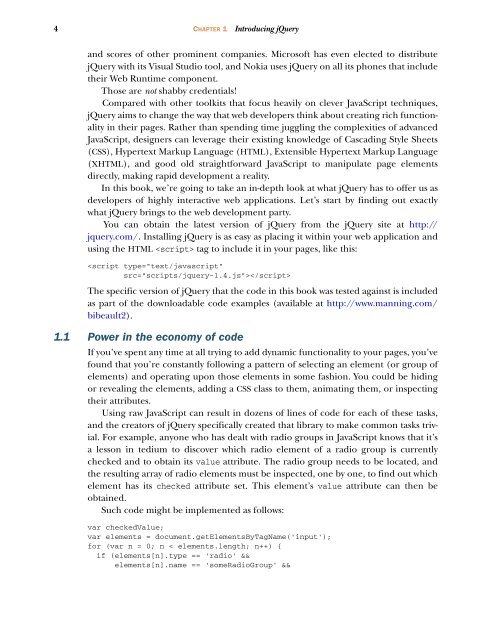IN ACTION
You also want an ePaper? Increase the reach of your titles
YUMPU automatically turns print PDFs into web optimized ePapers that Google loves.
4 CHAPTER 1 Introducing jQuery<br />
and scores of other prominent companies. Microsoft has even elected to distribute<br />
jQuery with its Visual Studio tool, and Nokia uses jQuery on all its phones that include<br />
their Web Runtime component.<br />
Those are not shabby credentials!<br />
Compared with other toolkits that focus heavily on clever JavaScript techniques,<br />
jQuery aims to change the way that web developers think about creating rich functionality<br />
in their pages. Rather than spending time juggling the complexities of advanced<br />
JavaScript, designers can leverage their existing knowledge of Cascading Style Sheets<br />
(CSS), Hypertext Markup Language (HTML), Extensible Hypertext Markup Language<br />
(XHTML), and good old straightforward JavaScript to manipulate page elements<br />
directly, making rapid development a reality.<br />
In this book, we’re going to take an in-depth look at what jQuery has to offer us as<br />
developers of highly interactive web applications. Let’s start by finding out exactly<br />
what jQuery brings to the web development party.<br />
You can obtain the latest version of jQuery from the jQuery site at http://<br />
jquery.com/. Installing jQuery is as easy as placing it within your web application and<br />
using the HTML tag to include it in your pages, like this:<br />
<br />
The specific version of jQuery that the code in this book was tested against is included<br />
as part of the downloadable code examples (available at http://www.manning.com/<br />
bibeault2).<br />
1.1 Power in the economy of code<br />
If you’ve spent any time at all trying to add dynamic functionality to your pages, you’ve<br />
found that you’re constantly following a pattern of selecting an element (or group of<br />
elements) and operating upon those elements in some fashion. You could be hiding<br />
or revealing the elements, adding a CSS class to them, animating them, or inspecting<br />
their attributes.<br />
Using raw JavaScript can result in dozens of lines of code for each of these tasks,<br />
and the creators of jQuery specifically created that library to make common tasks trivial.<br />
For example, anyone who has dealt with radio groups in JavaScript knows that it’s<br />
a lesson in tedium to discover which radio element of a radio group is currently<br />
checked and to obtain its value attribute. The radio group needs to be located, and<br />
the resulting array of radio elements must be inspected, one by one, to find out which<br />
element has its checked attribute set. This element’s value attribute can then be<br />
obtained.<br />
Such code might be implemented as follows:<br />
var checkedValue;<br />
var elements = document.getElementsByTagName('input');<br />
for (var n = 0; n < elements.length; n++) {<br />
if (elements[n].type == 'radio' &&<br />
elements[n].name == 'someRadioGroup' &&


